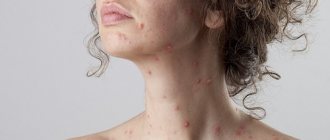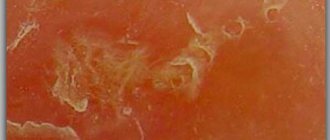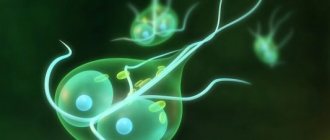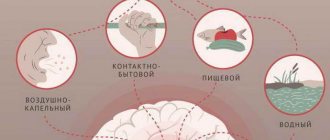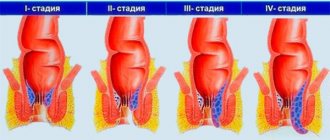(1 ratings, average: 5,00 out of 5)
Home » Skin spots
Any infectious disease in children causes concern among parents, so the question of what chickenpox looks like in children is always relevant. What is chickenpox, how does infection occur, and how all stages of the virus manifest themselves? You can learn about this in our article below.
general information
The danger of contracting chickenpox in adulthood is its severe course, the possible transition of the rash into a hemorrhagic or bullous form (when ulcers appear on internal organs).
In addition, an adult may experience serious complications in the form of encephalitis, disruption of the cardiovascular system, pyoderma or lymphadenitis.
Fun fact: “wind parties” were popular in the early 20th century. Parents deliberately brought their children to those who were already infected with chickenpox so that the child could easily transfer the disease.
Disease prevention
Vaccination is the most reliable way to protect against chickenpox. But it is not considered mandatory, it is carried out only at the request of the parents. Vaccination helps prevent the disease, but if a child does get sick, chickenpox is mild.
Some parents refuse vaccination, explaining that it is better for the child to get over chickenpox before school. It is believed that children will quickly cope with the disease and gain protection for the entire time.
But experts refute the arguments of young mothers, arguing that a baby who has recovered from the disease may still have the herpes virus, which in the future can cause the appearance of shingles. Therefore, decisions regarding vaccination should be balanced and well thought out.
On a note!
If a wave of disease begins in a child care facility, mothers should decide to vaccinate within the first 96 hours after their child comes into contact with sick children. After this time, the vaccine will no longer be effective, and the child will definitely get sick.
Pediatricians recommend vaccinating all children over one year of age. Repeated vaccination is done after 5 years. Vaccination does not cause any side effects; on the contrary, it helps to resist the virus, so experts recommend protecting children in this way.
Infection and stages of the disease
Chickenpox is transmitted by airborne droplets, which, interestingly, is the only virus to which susceptibility in humans is 100%. The pathogen enters the body through the respiratory system and penetrates the mucous epithelium. After the virus enters the bloodstream, a skin reaction begins: itching, swelling and the appearance of a rash.
Conventionally, the stages of the disease can be divided into several periods:
- Incubation – for adults from 11 days to 3 weeks, for children 2 weeks. At this time, chickenpox practically does not manifest itself; fever or weakness may appear.
- Prodromal – characterized by elevated body temperature, lower back pain, migraine, lasts 2-3 days.
- The period of appearance of the rash - in people over 30 years of age is accompanied by high fever, nausea, general weakness, and radiating pain throughout the body. Lasts from a week to 10 days.
After the crusts dry, the recovery stage begins, and the virus becomes no longer dangerous to others.
Read here: Herpes on the lips: types, symptoms and treatment. Which doctor should I contact and how do experts recommend treating herpes (115 photos + video)
Symptoms of chickenpox in children
Chickenpox is a viral infection, so its first signs are traditional for any viral disease. The initial stage of the disease is latent or incubatory. At this time, the virus multiplies and invades cells, but does not manifest itself in the form of fever or rashes. The incubation period for chickenpox lasts 21 days, after which a clear period of illness begins, with fever and rash.
The initial stage of chickenpox is accompanied by fever, headache, general malaise, difficulty breathing, a coated tongue, as well as aching, a painful reaction of the eyes to light. Therefore, the first manifestation of the disease can be confused with ordinary flu or acute respiratory infections. Further, as the virus develops, specific signs appear - rashes.
The first signs of chickenpox, which clearly indicate a herpes virus, are a blistering rash that spreads from the head and upper body. The rashes are distinguished by the presence of bubbles with liquid, which after a while burst to form wounds. After some time, the wounds heal.
If the wound takes a long time to heal, then a small spot will remain. Such spots in children can persist from several months to several years, after which they disappear with gradual renewal of the skin.
Let us consider the features of the manifestation of various painful symptoms with chickenpox.
Temperature with chickenpox
The rise in temperature during chickenpox can be different. Slight +37.3°C, and very high, up to +42°C. The temperature rises very high in adults. A slight rise in temperature can be observed in children, especially in breastfed babies.
_
Note: in the absence of fever and a small (2-3 pimples) number of rashes, chickenpox in children under one year of age may go unnoticed.
Chickenpox in infants occurs in a severe form if the child’s immunity is depressed. This condition is possible within 2-3 weeks after vaccination, after suffering from inflammation, or specific manipulations (blood transfusion, antibiotic treatment).
The rise in temperature is also small in preschoolers who rarely get colds. These facts indicate that body temperature during a viral (chickenpox) infection is determined by the human immune system. The more active the body’s defenses are, the less its rise.
Chickenpox rash
The main defining sign of chickenpox is the characteristic chickenpox or herpetic rash. Small pink pimples and blisters with liquid exudate are typical signs of a herpes infection. The type of chickenpox herpetic rash varies depending on the period of the disease:
- Initially, small pink dotted pimples appear, which can be confused with an allergic rash.
- After a day, pimples turn into so-called vesicles - they have bubbles with liquid contents. Initially, the contents of the vesicle are transparent. After a day, it becomes cloudy and bursts. In this case, the bursting of the vesicles is accompanied by severe itching.
- The cloudy liquid inside the bubbles is filled with many viral particles. After the vesicle bursts, they are able to go out and spread into the surrounding space. This is how the virus spreads and infects surrounding people. At this stage, the itching intensifies and sometimes becomes unbearable. It is a tool for spreading viruses. When constantly scratching a wound, viruses get onto your hands, and from them they easily spread around.
- Bubbles that burst turn into wounds and become covered with a crust. Under the crust they dry out within 6-8 days. After which the crust disappears, leaving no traces.
- The rashes continue in waves. When the first pimples have already burst, the next ones may still appear. Thus, within 4-5 days, a new rash appears on the human body every day. In order to distinguish new pimples from old ones, all existing rashes are smeared with fucorcin, iodine or brilliant green. Then the new rash will be clearly visible - it will not be painted over. Such manipulations make it possible to determine the end of the disease. After the last pimple appears, 5 days later the child can attend the children's group.
_
Scratching pimples with chickenpox is fraught with bacterial infection, sore wounds, and traces of scars.
If chickenpox scars remain, they look like pinpoint depressions that remain on the child’s skin for several years. To prevent this from happening, in case of severe itching, use special antipruritic agents. Or they often cauterize the rash with an alcohol solution of brilliant green and iodine.
Duration of the disease
How many children get chickenpox also depends on the person’s immunity. The duration of a viral infection is determined by the speed of the immune response. When an infection first enters, the body develops a program to combat it. This may take from one to several days. Afterwards, the synthesis of the necessary antibodies is launched, which will control the spread of the virus. Which can also take from several hours to several days. After the appearance of antibodies, the virus is limited in reproduction. Therefore, the number of new rashes is reduced less. After a few more days, the rash stops appearing completely.
Chickenpox in a child lasts until the body completely takes control of the herpetic virus. This can range from 2 to 14 days.
The nature of the rash with chickenpox
In adults, this virus causes massive rashes throughout the body, often accompanied by additional unpleasant symptoms. At first, the rash looks like small pinkish spots, about 2 mm in size. A few hours after their appearance, they enter the papules stage, then crusts appear on them, which disappear over time.
Rashes can also develop on the mucous membranes; they take the form of small ulcers and disappear together with the main symptoms of smallpox.
How to alleviate the condition of a sick child? Useful tips from experts
- It is better for a sick baby to be in a cool apartment. Intense heat increases sweating, which causes unbearable itching of the skin.
- Parents should dress their child in natural clothing. It is recommended to change bedding and the clothes the baby wears daily.
- Many parents prohibit their children from showering. They are wrong. This will only make it easier for the child. But swimming should be done in cool water. Taking baths with the addition of soda or a weak solution of potassium permanganate will reduce itching and help dry the wounds. After swimming, you should not dry your body with a towel, otherwise the bubbles may burst. You can only blot your body with a soft towel.
- If a very young child has chickenpox, he can wear soft gloves at night. This will prevent the bubbles from scratching.
- Sometimes, antihistamine ointments are prescribed during treatment. They should be used carefully to avoid overdose. The ointment should be applied directly to the site where the bubble appears.
Parents should remember the day on which the last bubble appears and there will be no more new rashes. After a week, you will be able to go outside with your child and take a walk in the fresh air. The baby will no longer pose a danger to others. It is not recommended to immediately send the little martyr to kindergarten. He needs to be left at home for a week or two so that he gets stronger and gains strength.
Features of the course in pregnant women
Herpes virus type 3 is incredibly dangerous when carrying a child, in the last stages of pregnancy. Small risks of developing complications exist in the first weeks; in the middle of the perinatal period, chickenpox does not pose a danger to the fetus.
If the infection occurs immediately before childbirth (a week or later), complications in the form of congenital chickenpox are possible. In such cases, the baby may experience breathing problems, inflammation of the bronchi, diarrhea and damage to internal organs. About 30% of cases end in death.
How to properly treat chickenpox?
If parents observe symptoms of chickenpox in children, treatment of the disease does not require antibiotics and antibacterial drugs.
Treatment depends on the symptoms:
- When the temperature rises to +38 °C, the baby is given paracetamol or ibuprofen.
- During illness, it is recommended to drink more fluid; you should not force your child to eat.
- Parents should monitor the child, lubricate new blisters with brilliant green, iodine or a solution of potassium permanganate and not allow them to be combed.
- The disease may be accompanied by severe itching. In this case, the doctor may prescribe antiallergic medications.
- If there is a fever during the illness, the child should spend all the time in bed.
Attention!
Under no circumstances should you give acetylsalicylic acid during the course of the disease!
The disease does not require hospitalization. All treatment can be done at home, but under the supervision of a doctor. At the first sign of unwanted complications, the specialist will recommend hospitalization.
Therapeutic measures
Conventionally, there are 2 stages of treatment for chickenpox in adults:
- relief of symptoms;
- dealing with the consequences.
During the course of chickenpox, all measures are aimed at improving the condition. For this purpose, antipyretic drugs (paracetamol, ibuprofen) and analgesics (analgin) are taken. To reduce itching, you can take antihistamine tablets (suprastin, diazolin), but as a rule, they do not help much.
At the second stage, the main problem is papules; if the patient scratches them, it is necessary to use antibacterial agents (brilliant, hydrogen peroxide). The oral cavity can be rinsed with furatsilin solution.
If there are scars left after chickenpox, you can use creams with bodyaga or mumiyo.
Allergic dermatitis - causes of appearance, first symptoms and treatment in children and adults (video + 130 photos)
Treatment of dermatitis - professional methods for effectively getting rid of the disease in different areas of the skin (105 photos)
Treatment of varicose veins - which specialist to contact and how the treatment procedure occurs. Stages of recovery and description of treatment (140 photos + video)
Despite the fact that the disease is of viral etiology, proper treatment of chickenpox in adults does not involve taking antiviral drugs or interferon analogues. In the case of this pathogen, they are ineffective.
Forms of chickenpox. How long will it take to recover?
Depending on the individual characteristics of the child, the duration of the disease lasts up to 8 days. This is the peak of the disease. After this, chickenpox stops and the child recovers. Spots after chickenpox disappear within 3-4 weeks. If the disease is severe, the spots on the body may not go away within 2 months.
Experts distinguish between typical and atypical chickenpox. In turn, typical is divided into mild, moderate and severe forms of the disease.
Mild form of chickenpox. This stage occurs without any symptoms: there is no increase in temperature, severe itching and numerous rashes. Only a few blisters may appear on the skin.
Average form of chickenpox. It is characterized by the appearance of rashes on the body, an increase in body temperature to +38 °C, no more.
Severe form of chickenpox. It is more typical for adults; it is rare in children. The onset of the disease proceeds as follows: the patient experiences a sharp increase in temperature to +40 °C, the entire surface of the body is covered with blisters. The patient becomes intoxicated. Numerous spots may merge into one large spot.
Pregnant women are more susceptible to severe chickenpox. It also does not bypass babies under one year of age, who have very weak immunity.
The atypical form of the disease is characterized by all the signs of the typical form, only with more pronounced symptoms. Sometimes the atypical form can begin and proceed without any symptoms.
Is it possible to independently distinguish chickenpox from measles and rubella?
Only a pediatrician can make a final diagnosis. However, an attentive parent will distinguish between the symptoms of infection by different viruses.
The first manifestations of measles will most likely be similar to the flu (very high, at 40 degrees, temperature, severe headache, loss of appetite). However, unlike the flu, measles is accompanied by a cough with signs of suffocation, severe inflammation of the nasal mucosa, pain and pain in the eyes, lacrimation and discharge of pus from the eyes, a rash appears behind the ears and on the bridge of the nose, but it is not itchy.
With rubella there will also be an elevated temperature, but up to 38 degrees. A characteristic sign of the disease will be enlarged lymph nodes, a dry, intermittent cough, a stuffy nose and copious watery discharge from it, severe redness and pain in the throat, as well as a round rash without itching.
Stages of the incubation period
The incubation period in adults occurs in 3 main stages. Let's look at each stage and characteristic symptoms.
Initial (prodromal) period
It begins from the moment of contact (infection) and continues for a day (rarely up to 3 days). During this period, an adult usually does not realize that he has contracted chickenpox. The virus enters the human body through the upper respiratory tract, fixes on the cells of the mucous membrane, where its primary accumulation occurs.
Climax period
The Varicella Zoster virus enters the regional parts of the lymphatic system. During this period, the very first symptoms may appear (decreased appetite, fatigue, weakness, general loss of strength). In some cases, there may be symptoms that can easily be confused with ARVI or a cold (runny nose, sore throat, cough, etc.).
The diagnosis becomes clear with the appearance of the first rashes characteristic of chickenpox.
Final stage
At the end of the incubation period it enters the blood and fever appears. At the final stage, the human immune system actively fights the chickenpox virus, the body produces antibodies and mobilizes humoral and cellular immunity.
Skin cells are affected by the chickenpox virus and the first rashes begin to appear. The patient may have muscle pain, chills, fever, and itching.
Rarely, chickenpox can occur in an erased (hidden) form, without fever and other manifestations of intoxication. In a patient with chickenpox of this form, several blisters appear on the scalp and single manifestations on the body. There are also severe forms of the disease - bullous, hemorrhagic and gangrenous.
It is known that in adults and adolescents the disease is often more severe than in children. Currently, drug therapy and the use of modern antiviral drugs will help avoid complications.
The approximate period of temporary disability for patients with chickenpox is 9–15 days.
What is chickenpox?
Chickenpox is an infection caused by the Varicella zoster virus. Spreads through direct physical contact, sneezing or coughing.
The picture shows what the Varicella Zoster virus looks like:
This is how the virus spreads through the bloodstream throughout the human body:
Children are most susceptible to the disease, but adults can also easily become infected if they have not been sick before. Moreover, the course of the disease in adults will be much more acute: high fever, very profuse rashes, ulcers on the body.
What to do for prevention
As a preventive measure, adults should avoid contact with infected people to prevent a possible relapse. If someone in the family gets sick, they need to:
- place in a separate room;
- carry out periodic ventilation and clean the housing with damp rags;
- when communicating with the patient, use a cotton-gauze bandage;
- wash your hands frequently.
Although due to increased sensitivity to infection, prevention may be ineffective.
The main goal of treating chickenpox in an adult is to get rid of the symptoms and stop the development of the virus, as well as prevent the formation of possible consequences.
We recommend! No more rashes, itching, burning and other symptoms of HERPES! Our readers have been using this method to treat herpes for a long time. Continue reading >>>
What does chickenpox look like: the first signs
Chicken pox, or simply chickenpox, is a childhood infectious disease. The causative agent is a type of herpes virus Varicella Zoster, which is transmitted from an infectious child to other members of the children's team.
A child infected with chickenpox will feel fine at first. Only after the end of the latent period will the initial signs of chickenpox appear in the child.
The appearance of the chickenpox rash
How can you tell if your baby has chickenpox? Its distinctive feature is a pink rash, which consists of convex nodules no more than 4-5 mm in diameter.
Each nodule (papule) on the patient’s body goes through several stages of transformation:
- After its appearance, it begins to fill with liquid and increase in size, turning into a vesicle.
- Then its contents become cloudy and it bursts.
- From this moment the healing of the wound begins - it becomes covered with a crust, which later disappears.
At the same time, the baby may develop a fever, aches in the joints, and general weakness. There may be mild signs of respiratory illness.
Dynamics of the disease
A child has chickenpox - what are the dynamics of the onset of symptoms of this disease? The temperature occurs only at the beginning of the disease, then it gradually normalizes.
Pimples appear and disappear in waves. Papules very quickly begin to cover an increasingly larger surface of the body, but it happens that they are localized only on the back, abdomen and on the bends of the limbs. While the acute stage of the disease lasts, a rash of varying degrees of maturity can be seen on the child’s body at the same time.
The photo shows what papules, vesicles and drying crusts look like.
In parallel with the rash, which often covers the face and even the head under the hair, enanthem may occur on the oral mucosa. These are the same pimples as on the body, but after they burst, a small ulcer with a yellow edging remains in their place. After appropriate treatment, the wounds in the mouth heal.
You can see what pimples look like by looking at the photo.
Papule Vesicles Rash of varying degrees of maturity Rash in the final stage
Chickenpox most often affects young children. In a one-year-old child and children under 12 years of age, the disease usually occurs without complications and is easily tolerated, forming lifelong immunity. Does a teenager get chickenpox? The course of the disease will be more severe than in younger children. The worst thing is if chickenpox strikes an adult, since in this case the disease is most severely tolerated.
How many days does the incubation period last?
According to the National Infectious Diseases Research Society:
“The incubation period in adults lasts from 1 to 3 weeks (21 days), with most being 14-17 days.” Has a hidden character. It does not affect the patient’s well-being at first. The risk of a person becoming ill throughout his life, from childhood onwards, is 95%.
An adult is considered already infectious on the last day of the incubation period and in the first 5–7 days from the moment the rash appears.
Infection usually occurs through airborne droplets. The virus is poorly stable in the external environment and quickly dies when exposed to sunlight, ultraviolet rays and heat. The air current can penetrate and travel long distances (from one floor and above, to adjacent rooms).
Chickenpox virus (Varicella zoster)
The incubation period in adults ends with the appearance of the first symptoms (fever, rashes, weakness, muscle pain).
What chickenpox looks like photo
The main symptom by which you can understand what chickenpox looks like (photo 4) is a rash. At first, these are ordinary red spots of small size and round shape. The early stage of chickenpox first appears on the head and abdomen. As a result, the spots turn into papules (this is what pimples with chickenpox are called). The center of the area of reddened skin rises, and a blister filled with clear liquid forms.
The chickenpox rash (photo in the gallery) subsequently transforms from a papule into a vesicle with purulent contents. Itching appears, which accompanies the process of opening acne. The next sign of how chickenpox manifests itself is ulceration of the papule with the formation of a scab or other crust. But this happens at a later stage.
Chickenpox in an adult patient: treatment of mild forms
Therapy for mild forms of the disease is based on eliminating symptoms and alleviating the course of the pathology. Every day, at least 2 times a day, all rashes should be treated with a solution of brilliant green. Also, for preventive purposes, the patient’s skin is wiped daily with a weak solution of manganese. Additionally, oral administration of antiviral drugs is recommended. The most effective drug is Acyclovir. The drug is aimed at combating herpes viruses.
It is necessary to allocate a separate room for the patient where he will stay during the treatment period. The room must be ventilated daily, it is advisable to open the windows for 1-2 hours, regardless of climatic conditions. It is recommended to drink at least 2 liters of purified water and tea per day.
Treatment involves not only the use of medications, but also a diet that will help reduce itching. During the therapy period, you should completely avoid eating fried, salty, sour and smoked foods.
Additionally, the use of mild sedatives (Barboval, Valerian) for a more restful sleep is allowed.
